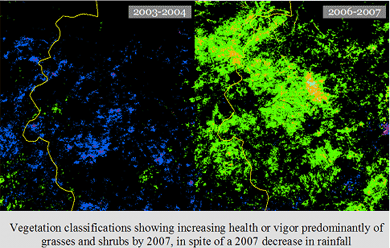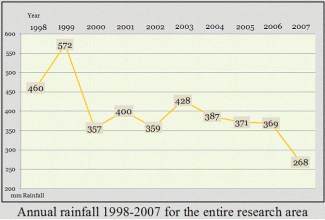Prior to the genocide in Darfur, 80 percent of Darfur’s economy relied on agricultural activities, primarily livestock. This loss of livestock has had an enormous impact on the peoples of Darfur. Our findings show a direct correlation between the displacement of local populations and the looting of livestock, as evidenced in the rebound of vegetation coverage and vigor. These findings strongly suggest that much of the population of Darfur has been displaced from their normal habitats, and economic and subsistence means.
Remote sensing applications can measure the health and vigor of vegetation and availability of water, as well as the speed of environmental recovery, and judge the stress humans and their activities place on the environment. We used two satellite imagery products to measure change in land cover, MODIS Terra and SPOT Vegetation, and one to measure annual rainfall, TRMM. The remote sensing application Normalized Difference Vegetation Index (NDVI) was the primary means for measuring land cover change and vegetation health (vigor).
Our annual rainfall findings show a steep overall decrease in rainfall from 1999 to 2000, which corresponds to the reported 2000 drought. But after 2000, there was no return to pre-2000 annual rainfall means. Instead rainfall remained relatively constant until 2007, when there was another dramatic decrease in mean rainfall for the entire region.
In order to record any change in biomass, it was important not just to understand change as a function of spatial coverage, i.e., two-dimensionally, but also to add a third dimension— vegetation vigor or health. Simply knowing where and how much vegetation coverage has changed annually does not necessarily convey how healthy the vegetation was for each year. These are in fact two different measurements. The data show a downward slope in mean vegetation vigor from 2000 to 2003. But after the genocide began in 2003, the trend reverses and the mean begins sloping steadily upward, despite a continuing decrease in annual rainfall.
In the period from 2003 to 2005, massive government-sponsored livestock looting occurred. The overall rebound of vegetation throughout the impacted regions of Darfur, most evident in 2007, is likely the result of two factors: a decrease in overall livestock numbers in Darfur and the difficulty of resettlement under an ongoing threat of violence. Because 2007 also saw the lowest rainfall in more than a decade, traditional land use has been dramatically altered. The livestock wealth has disappeared and, according to recent reports, much of Darfur is facing famine.(1) The rebound of vegetation is a result not of intensified agrarian activities, but of depopulation.


